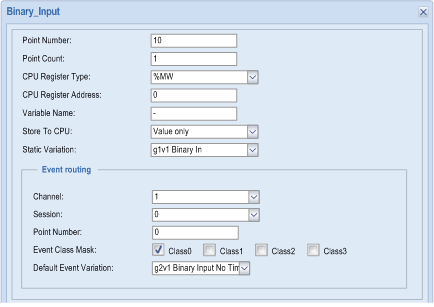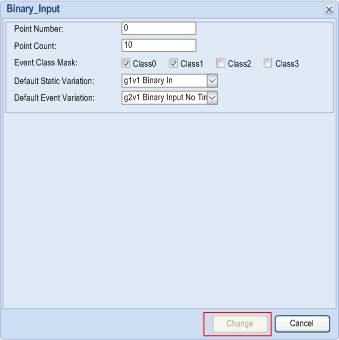The events routing component allows events from sub stations to be routed to SCADA within one BMXNOR0200H module.
To route events, one RTU master channel and at least one RTU slave channel are needed inside the system. The solution is to create a logic RTU master and slave in a single BMXNOR0200H module. In the logic master, points are created to represent points in sub stations, and in the logic slave, points are created to simulate the behavior of points in sub stations. Events routing component is responsible for collecting events in the logic master. These events are sent from sub stations, and trigger the same events in the logic slave.
BMXNOR0200H module components:
NOTE: Routing capabilities are only possible within a single module.
There are no automatic routing capabilities between two BMXNOR0200H modules (a slave/server and a master) configured in the same station.
In a hierarchical architecture, time stamped events are automatically transferred from low end slave sub stations to the SCADA (or master) through the station. The automatic transfer uses path-through events functionality with a single BMXNOR0200H module configured in both slave and master.
Configure the BMXNOR0200H module for event routing. Most of the BMXNOR0200H module parameters are configured via webpages as are the event routing functions. There is no dedicated webpage for the events routing function, this function is configured inside the data mapping configuration pages.
NOTE: The BMXNOR0200H does not detect events for the routing points in slave.
NOTE: With the loss of power management, you can specify in the configuration if you want to poll more events from the BMXNOR0200H modules, fallback to SCADA and prevent events from being lost.
Channel Configuration
For routing events, configure one master channel and at least one slave channel. One master channel is required so that the system can connect with more sub slaves, and more slave channels allow for more SCADA in the system.
Master Data Mapping Configuration
You must first add data points in the master channel. These points represent points in the sub slave which communicate with the master channel.
Master points mapping:
When configuring these points in the master channel, select the events of the point which needs to be routed, and route events to the corresponding slave channel.
For example, if the master channel needs to receive events from the sub slave Binary Input point, routed it to the logic slave channel and so that becomes an event of the Binary Input point.
Master points configuration:
NOTE:
-
When the user specifies one point in the master for event routing such as the binary input point, one corresponding point configuration is automatically generated in the logic slave channel. The point configuration is read only in the logic slave channel, and cannot be changed or removed in its DB mapping panel.
-
If the channel number, session number, or point number mismatches in the slave channel, an error page appears.
-
If the user chooses the route to the channel as None, this means that this point does not need to be routed to a slave.
Slave Points Configuration
After configuring the points in the master channel, the corresponding point is listed in the slave channel.
Slave points mapping:
The points used to route are different from the normal points of the slave. The parameters (CPU type, CPU address, variable name, and time stamp) of CPU mapping are no longer available, and the available parameters are read only. Their lifetime is consistent with peer point configuration in the master.
Slave points configuration:
Channel Combination for Events Routing
The supported combinations are:
|
Master channel
|
Slave channel
|
|
DNP3 net client
|
DNP3 net server
|
|
DNP3 serial master
|
DNP3 net server
|
|
IEC-104 client
IEC-101 master
|
IEC-104 server
IEC-104 server
|
-
Events are routed inside the module. This means that it is not possible to route events between two or more modules and also that the PLC application in the CPU cannot get and process the events (the CPU can still get the point value in events just like the standalone master channel).
-
Events and static points are routed. Requests (commands) from SCADA are not routed to the sub slave. This means that inside the BMXNOR0200H module, there is no other data exchange or communication between the master channel and the slave channel except for events.
-
Not all master and slave channel combinations are supported by the
routing function.
-
In the system, SCADA cannot communicate with sub slaves. The solution uses the logic slave in the BMXNOR0200H module to simulate sub slaves, so SCADA can only communicate with the logic the slave in the BMXNOR0200H module, and sub slave can only communicate with the logic master in BMXNOR0200H module.
-
Some information related to events may be changed. Key information related to events like point value, flag, and timestamp is kept during routing. Other information related to events like point number, events class, and variation is changed according to the slave channel configuration.
The events buffer of the slave must be greater than the events buffer in the sub slave otherwise events are lost.





